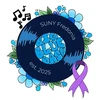Anglers appreciate steelhead trout in Chautauqua County - swimming like fluid silver through Chautauqua County streams. The economic impact of the steelhead sport fishing industry has been the recent study of environmental and natural resources economist Dr. Peter Reinelt of the Department of Economics in the School of Business.
Dr. Reinelt, who also serves as chair of the department, noted steelhead are not native to the area, but were first stocked in Lake Erie during the late 1800s. The creek steelhead fishing season is not in the summer, when the trout are in the deep cool water of Lake Erie, but in spring, fall and winter when they migrate from the lake up area creeks and tributaries. Up-to-date information on fishing conditions is posted by the New York State Department of Environmental Conservation on the Lake Erie Fishing website.
As part of its angler survey conducted every three years, the New York State DEC Lake Erie Fisheries Unit, including fisheries biologist Jim Markham, collaborated with Dr. Reinelt to develop some questions to help assess the economic impact of steelhead trout fishing in Cattaraugus, Chautauqua and Erie counties. They hoped to build on an effort completed in nearby Pennsylvania. Assisting with the data analysis on the project was economics major and 2009 alumnus Mike Lesinski, and software to complete the data analysis was acquired with support of the Chautauqua County Industrial Development Agency.
The survey interviewed 1,981 anglers from throughout the United States including California, Georgia, Massachusetts, Maine, Missouri and Texas, and from neighboring Ontario and Quebec. Results showed that $3.3 million total was spent by steelhead anglers, including travel and gear, and $2.8 million in the three-county area of the survey.
Dr. Reinelt also studied the amount of “unique spending”– dollars that would otherwise not be spent in the area without steelhead fishing. This included direct effects, such as increases in the local economy including items like lodging, restaurants, fishing guides and gear and gas purchases; indirect effects, such as greater spending by local businesses at their local suppliers; and the induced effect, or the increase in spending from income of jobs created by the spending of steelhead anglers. All told, the New York steelhead fishery creates 33 jobs and increases regional economic output by $2.6 million annually after accounting for spending that “leaks out” of the area to non-local suppliers. The survey also indicated that approximately $190,000 in the year studied was spent hiring fishing guides.
SUNY Fredonia has another link to the fishing industry. Department of Visual Arts and New Media Distinguished Professor Alberto Rey is also an Orvis Endorsed Fly-Fishing Guide, and has also volunteered as the director and founder of a local youth fly fishing program for the past 14 years. Fishing and steelhead are reflected in his artistic efforts which can be found in museum collections around the country as well as throughout campus.
Dr. Reinelt noted that his future research interests are to study the economics of water in the area, climate change and carbon capture. Does he fish? Dr. Reinelt said he fished for trout a lot with his Dad growing up in Northern California, and hopes it will be something he can share with his children. School of Business Dean Russell Boisjoly commented,
“Community engagement and experiential learning are central to the mission of the School of Business and part of the strategic goals of SUNY Fredonia. We have a very extensive set of learning opportunities for our faculty and students that include conducting projects for local companies and non-profit organizations, internships at our Technology Incubator with some very exciting start-up companies, internships with the Chamber of Commerce, Chautauqua County Visitors Bureau, Dunkirk Development Corporation, Dunkirk Mayor’s Office, and many manufacturing and service companies.”



